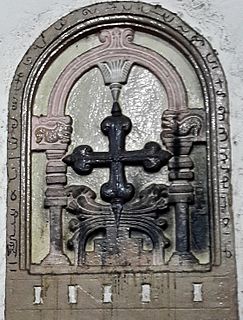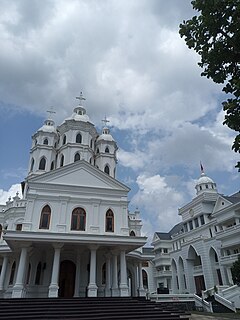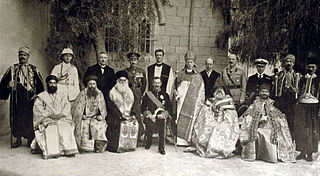
The Syriac Orthodox Church, officially known as the Syriac Orthodox Patriarchate of Antioch and All the East, and informally as the Jacobite Church, is an Oriental Orthodox church that branched from the Church of Antioch. The bishop of Antioch, known as the patriarch, heads the church, claiming apostolic succession through Saint Peter in the c. 1st century, according to sacred tradition. The church upholds miaphysite doctrine in Christology, and employs the Divine Liturgy of Saint James, associated with James, the brother of Jesus. Classical Syriac is the official and liturgical language of the church.

Alphabetical list of Eastern Christianity-related articles on English Wikipedia

Mor Gregorios Abdal Jaleel Bawa was the Syriac Orthodox Bishop of Jerusalem from 1664 until his death in 1681. He is chiefly remembered for his 1665 mission to India, by which he established ties between the Malankara Church and the Syriac Orthodox church of Antioch. He is venerated as a saint by his church.

The Jacobite Syrian Christian Church (JSCC), also known as the Malankara Jacobite Syrian Orthodox Church, the Jacobite Syrian Church, and the Syriac Orthodox Church in India, is an autonomous Oriental Orthodox church based in Kerala, India, and is an integral branch of the Syriac Orthodox Church of Antioch. It recognizes the Syriac Orthodox Patriarch of Antioch and All the East as supreme head of the church. It functions as a largely autonomous unit within the church, under the authority of the Catholicos of India, Baselios Thomas I. It is currently the only church in Malankara that has a direct relationship with the Syriac Christians of Antioch, which has continued since the schism of 1665 and employs the West Syriac Liturgy of Saint James.

Manjanikkara Dayara is a monastery of the Syriac Orthodox Church. It is situated at the top of the hillock in Manjanikkara, near Omallur, Pathanamthitta District, in South Kerala, India. The monastery was established by Mor Yulios Elias Qoro, Patriarchal delegate to the Malankara Church. The Manjanikkara Dayro is the seat of the Patriarchal Delegate to Malankara and the metropolitan of the Simhasana churches .
The Catholicos of India, officially the Catholicos of the East and Metropolitan of Malankara based on the Syrian Orthodox Church Constitution, is an ecclesiastical office in the Syriac Orthodox Church, the head of the Jacobite Syrian Christian Church in Kerala, India. He is the Catholicos/ Maphrian of the Jacobite Syrian Christian Church an autonomous body with in the Syriac Orthodox Church, and functions at an ecclesiastical rank second only to the Syriac Orthodox Patriarch of Antioch. The jurisdiction of the Syriac Orthodox Catholicos of India and Indian diaspora based upon the regional (Indian) constitution of the church. The regional (Indian) constitution of the church renamed it as ‘Catholicos of India’ in accordance with its actual jurisdiction. The current Catholicos of the East and Metropolitan of Malankara is Catholicos Baselios Thomas I, who was consecrated in 2002.

Christianity is the third-largest practiced religion in Kerala, accounting for 18% of the population according to the Indian census. Although a minority, the Christian population of Kerala is proportionally much larger than that of India as a whole. A significant portion of the Indian Christian population resides in the state.
Karingachira St. George's Jacobite Syrian Church of Jacobite Syrian Christian Church, established in 722 AD, is one of the ancient churches of the Syriac Orthodox Church. St. Thomas, one of the twelve apostles of Jesus Christ is the founder of the ancient church in India. Christian writers and historians from the 4th century refer to the evangelistic work of Apostle Thomas in India, and the Indian Christians ascribe the origin of their church to the labours of the apostle in the 1st century.
St. Mary's Simhasana Church, Vadayaparambu is one of the prominent Syriac Orthodox churches in Kerala. The church was established in 1975 by Dr. Geevarghese Mor Gregorios. The church is headed by the "Patriarch of Antioch" and functions under the spiritual supremacy of the Syriac Orthodox Patriarchate of Antioch and all the East and the Regional church headquarters is at Puthencuriz, Kochi.

Dioceses of the Syriac Orthodox Church: In the period of its greatest expansion, in the Tenth Century, the Syriac Orthodox Church had around 20 metropolitan dioceses and a little over a hundred suffragan dioceses. By the Seventeenth Century only 20 dioceses remained, reduced in the Twentieth Century to 10. The seat of Syriac Orthodox Patriarch of Antioch was at Mardin before the First World War, and thereafter in Deir Zaʿfaran, from 1932 in Homs, and finally from 1959 in Damascus.

Moran Mor Ignatius Aphrem II is the Patriarch of the Syriac Orthodox Church. He became the 123rd Syriac Orthodox Patriarch of Antioch when he was enthroned as patriarch in Damascus on 29 May 2014. Before his election to the patriarchate, he was Archbishop for the Eastern United States of America, and known as Mor Cyril Aphrem Karim in that post. In that role, he established 11 new parishes, introduced a number of new programs for the youth, and worked for inter-church unity.

E. A. E St. Mary's Soonoro Syriac Orthodox Church, Meenangadi, is a Marian Pilgrim center of the Syriac Orthodox Church located at Meenangadi in Kerala, India. The church is under E.A.E Arch Diocese, the first missionary association of Syriac Orthodox Patriarchate of Antioch and All the East, and is currently under the direct control of Ignatius Aphrem II, Patriarch of the Syriac Orthodox Church. In 2006, the church was elevated to the status of "Marian Pilgrim Centre", and in 2018, it celebrated its diamond jubilee. It is the first church to adopt the 8 Day Lent in Malabar Region.

The Holy Girdle, also known as the Girdle of Thomas, Holy Girdle of Mary, Holy Soonoro, (or) Zunoro, and Holy Belt of Saint Mary the mother of Jesus, is a relic of the Blessed Virgin Mary which is one of the important relics of Syriac Orthodox Church and venerated by Oriental Orthodox Communion. The word "soonoro" is also translated as "belt", "sash" or "girdle". It is the Oriental Orthodox equivalent of the Girdle of Thomas in the Western church, and the Cincture of the Theotokos in the Eastern Orthodox Church, now located at Mount Athos.
St. Mary's Church or Marth Maryam Cathedral is a valiyapally situated in Kothamangalam town of India. It is located in Ernakulam district of Kerala state, India.

St. George's Monastery is a Jacobite Syrian Christian Church situated at a hilltop near Puthencruz, Ernakulam District, Kerala. The monastery was established by Mor Yulius Elias Qoro. The Malankara Syrian Orthodox Seminary began functioning in this monastery and later moved to Udayagiri. The monastery is the final resting place of Catholicos Baselios Paulose II. In 2019, a retreat house named Khanema Hanna Home was consecrated by Ignatius Aphrem II Patriarch near to the Monastery.
The Syriac Orthodox Patriarch of Antiochܦܛܪܝܪܟܐ ܕܐܢܛܝܘܟܝܐ is the head of the Syriac Orthodox Church of Antioch. He is the Head of the Holy Synod of the Syriac Orthodox Church, the highest authority of the Syriac Orthodox Church.
Saint Coorilos Paulose of Panampady, also known as Kochuparambil Thirumeni, or Panampady Thirumeni, was Malankara Metropolitan of the Jacobite Syrian Christian Church in India from 1911 to 1917.
Syriac Orthodox Patriarchal Delegates of India or the Syriac Orthodox Patriarchal delegate to the India is the representative of the patriarch of the Syriac Orthodox Church, who is sent to India to guide and administer the church, or on special occasions, as the representative of the Holy See of Antioch.

The Holy and Ancient Archdiocese of Jerusalem, All Palestine, and All the Near East or the Coptic Orthodox Patriarchate of Jerusalem, is a Metropolitan Archdiocese of the Coptic Orthodox Church, which is part of the wider communion of the Oriental Orthodox Church. It is headed by the Coptic Orthodox Metropolitan Archbishop of Jerusalem, the incumbent being Metropolitan Archbishop Antonious of Jerusalem since 2016. Its jurisdiction covers those Coptic Orthodox Christians living in the Near East; with churches and monasteries in the State of Palestine, the State of Kuwait, the Hashemite Kingdom of Jordan, the Lebanese Republic, the Syrian Arab Republic, and the Republic of Iraq. The adherents are largely of Coptic Egyptian descent, mainland Coptic migrants and their descendants. The archdiocese is based at St Anthony's Monastery, in the Christian Quarter of the Old City of Jerusalem, beside the Church of the Holy Sepulchre.
















